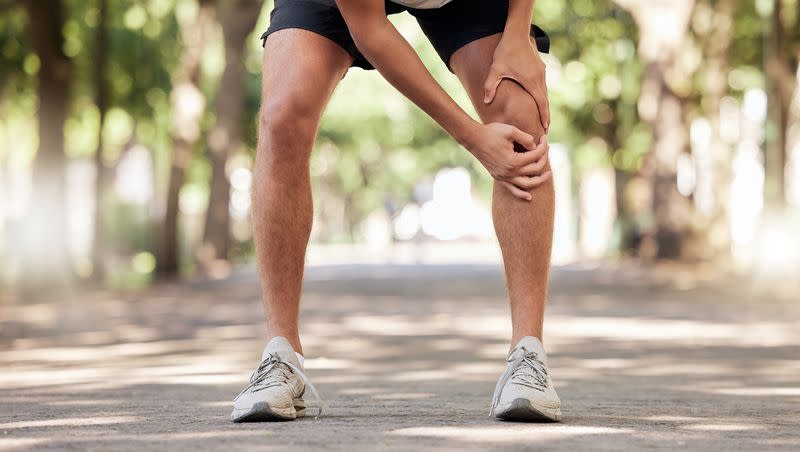Managing arthritis pain: 6 effective exercises for joint health

Living with arthritis doesn’t mean you have to live an inactive lifestyle in fear of causing yourself more pain.
In fact, “Regular physical activity can keep the muscles around affected joints strong, decrease bone loss and may help control joint swelling and pain. Regular activity replenishes lubrication to the cartilage of the joint and reduces stiffness and pain,” per Johns Hopkins Arthritis Center.
The Centers for Disease Control and Prevention said that in the United States, “24% of all adults, or 58.5 million people, have arthritis. It is a leading cause of work disability, with annual costs for medical care and lost earnings of $303.5 billion.”
Engaging in a 30-minute workout five days a week can help maintain flexibility in the limbs and ensure muscles remain relaxed, the Deseret News previously reported. The CDC advises that engaging in any form of physical activity, regardless of its type, can enhance the quality of life and functionality of individuals with arthritis.
If you have arthritis, it’s essential to find ways to work out that won’t exacerbate your condition. Here are seven workouts to promote physical activity and improve your overall health while living with arthritis.
What is the best workout for arthritis?
1. Swimming
Exercising in water provides resistance, which can help strengthen your muscles, but it’s gentle on the joints. Water buoyancy also reduces the weight-bearing strain on your joints.
According to the Arthritis Foundation, “Water aerobics, which involves your upper and lower body and mid-section, is usually done in chest-deep water, lessening impact on your joints by 75% compared with traditional aerobics.”
Many community centers and gyms offer water aerobics classes designed for people with arthritis.
2. Walking
Walking is a great way to reduce pressure in your joints at a pace that is comfortable for you.
Versus Arthritis recommends taking it slow when starting out. Think “about what works with your daily routine. For example, moving around the house, walking the kids to school, or arranging a walk with a friend.”
Adding that, “Once you’ve got used to walking more regularly, you can choose to gradually lengthen your walks, or maybe you could walk a few more days each week.”
3. Yoga
The gentle stretches and postures in yoga can increase flexibility and strength. If you choose to go to a yoga studio, inform your instructor about your arthritis so they can suggest modifications for any poses that might be challenging.
Yoga can also ease pain from increased joint pain due to misalignment. It can help with “proper alignment of the skeleton, which helps alleviate joint pain caused by misalignment. Keep in mind that any movement can be modified to minimize pressure or pain to already achy areas of the body,” per Cleveland Clinic.
Emphasizing that “Exercise has long been considered key to maintaining and improving joint function. It also helps strengthen the muscles around the joints so that sore and damaged joints are protected and aren’t overtaxed.”
Related
4. Strength training
Using light weights or resistance bands can help build muscle strength, which supports and protects joints.
It’s important to learn the correct technique, so consider hiring a personal trainer or physical therapist who has experience working with arthritis patients. Harvard Health said that strength training is good for nearly everyone.
“Schedule workouts for times of the day when you are least likely to suffer from inflammation and pain. Avoid exercising when stiffness is at its worst,” adding that you should rest at any point you feel you may be pushing yourself too hard.
“In some cases, water workouts may be a better choice than strength training. Exercise within a comfortable range of motion. If an exercise or movement causes significant pain, stop doing it! Discuss your options with a trainer or physical therapist,” Harvard Health said.
5. Pilates
Pilates focuses on core strength, flexibility and balance. Like yoga, inform your instructor about your arthritis to get guidance on modifications or alternative exercises.
Pilates exercises deal a lot with repetition techniques. “Through repetition, endurance of these muscle groups is increased, meaning there is less load on stiff, irritated joint surfaces and overall posture and body movement gets better over time,” per Ballsbridge Physiotherapy Clinic.
6. Stretching
Regular stretching can help maintain joint flexibility. This can be done daily and can be incorporated into your morning routine or done as a cool-down after exercise.
The Arthritis Foundation said that you should make it a habit to stretch daily and added that “stretching particularly benefits those with arthritis by lubricating joints and enhancing and maintaining range-of-motion.”
Stretching also helps prevent injuries when performing more intense physical activities.

